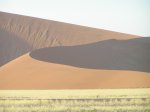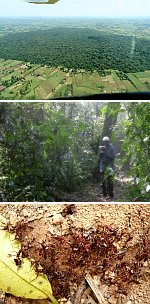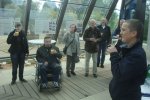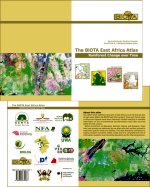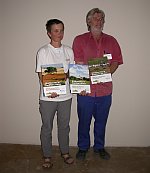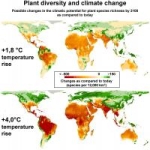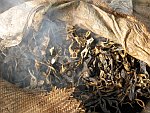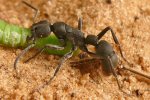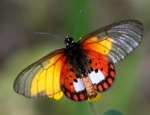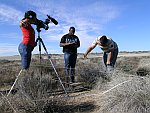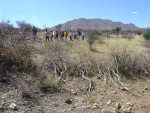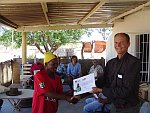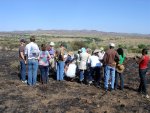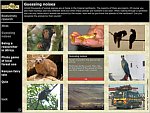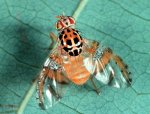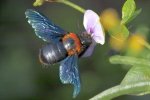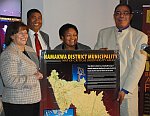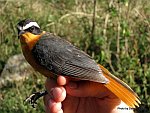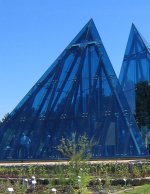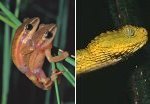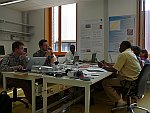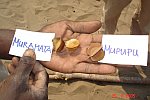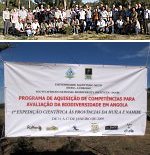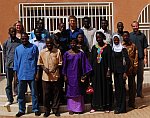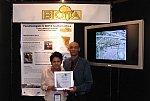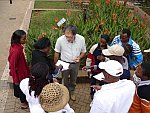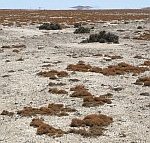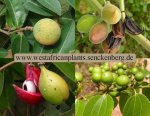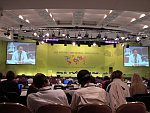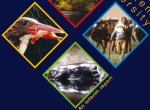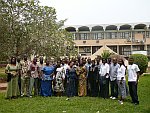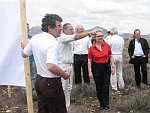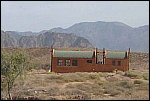 



Weather data
A large number of automatic weather stations has been implemented in the frame of the BIOTA AFRICA project by the Namibian National Botanical Research Institute (NBRI) and the Group "Biodiversity, Evolution and Ecology" (BEE) of the University of Hamburg. The website offers hourly updates of data and graphs of a large number of weather parameters.

|
News
 |
Verursacher der Feenkreise entdeckt: Im südlichen Afrika, etwa in Namibia und Angola, erinnern Graslandschaften nicht selten an einen Schweizer Käse, denn mitten in den grünen Flächen finden sich in regelmäßigen Abständen kahle, unterschiedlich große, aber immer kreisförmige Flecken. Bisher war wissenschaftlich nicht geklärt, wie diese sogenannten Feenkreise entstehen. Doch wie Prof. Dr. Norbert Jürgens, Professor für Biodiversität, Evolution und Ökologie der Pflanzen an der Universität Hamburg, in einem aktuellen Beitrag für das Magazin "Science" (Ausgabe vom 29. März 2013) berichtet, sind die Verursacher nun gefunden: Die Termiten der Gattung Psammotermes, die sogenannten Sandtermiten.
-
Science 29. März 2013, Vol. 339 no. 6127: The Biological Underpinnings of Namib Desert Fairy Circles
 Weblink
Weblink
- Newsletter der Universität Hamburg, April 2013, Nr. 49: Verursacher der Feenkreise entdeckt: Sandtermiten schaffen in Afrika natürliche Wasserspeicher für ihr Ökosystem
 Weblink
Weblink
- National Geographic 28. März 2013: Africa's Weird Fairy Circles are Termite-Built Water Traps
 Weblink
Weblink
- Spiegel Online 28. März 2013: Sensationen der Savanne: Feenkreis-Rätsel lässt Forscher verzweifeln
 Weblink
Weblink
- epoFILM: Namibia – Das Geheimnis der Feenkreise - ein Film von Barbara Fally-Puskás
 Weblink
Weblink
|
 
Photo: Norbert Jürgens
|
 |
New publication: Knowledge lives in the lake. Case studies in environmental and customary law from southern Africa, edited by Manfred O. Hinz; Oliver C. Ruppel and C. Mapaure (2012): Windhoek, Namibia Scientific Society.
Knowledge lives in the lake. Case studies in environmental and customary law from southern Africa is a recently launched book that follows Biodiversity and the ancestors. Challenges to customary and environmental law. Case studies from Namibia and published in 2008 (Windhoek: Scientific Society). Like its predecessor, Knowledge lives in the lake contains research by law students done within the framework of the BIOTA AFRICA sub-project administered by Manfred Hinz for the Faculty of Law of the University of Namibia and by the co-editors Hinz and Ruppel who also supervised the work assembled in the book. Some of the contributions contained in Knowledge lives in the lake reach beyond BIOTA AFRICA and bridge to the Future of the Kavango Project (TFO).
The contributions: Manfred Hinz wrote an introduction in which he applies the current discussion on the architecture of governance and law in the globalising world to the political vision of Agenda 21, as it was adopted in the Rio Earth Summit in 1992. Knowledge lives in the lake offers studies by
-
P. Anyolo on Namibian conservancies in general and the Uukwaluudhi conservancy; by A. Takaendesa on the situation of black Rhino in Zimbabwe,
-
N. E. Namwoonde on the problem of the registration of communal land in the Kavango Region and the Jatropha biofuel production in the Kavango and Caprivi Regions,
-
C. Mapaure on the legal status of trees and two studies on water law,
-
A. Zender on possible prevention of land degradation; and a final contribution by
-
Oliver Ruppel and Sanita van Wyk, a post-graduate student of the University of Stellenbosch, on an important water case decided in Botswana.
The title: Knowledge lives in the lake refers to a statement by the famous South African traditional healer and writer Credo Mutwa, who refers to his grandfather guiding him into the world of African spirituality:
There is [the grandfather said] a huge unseen lake somewhere in the spirit world where all the knowledge of the universe - past, present and future - is to be found." Knowledge lives in the lake in the form of little silver fishes," my grandfather said.
The papers on water - water as a lifeline, water as a right, and the socio-political implication of water as a common good - are not only major contributions to this publication; the socio-economic framework responsible for the water of the Kavango River is also central to work that has taken up at least certain aspects of the BIOTA AFRICA Project and will occupy the consortium of researchers until 2015, namely The Future Okavango (TFO) Project.
The book is available in Namibia from the Namibia Scientific Society in Windhoek and all Namibian bookstores. In Germany, it can be obtained from the Namibiana Buchdepot in Delmenhorst.
ISBN 978-99916-855-8-8 (Namibia)
ISBN 978-3-941602-75-5 (Germany)
|
 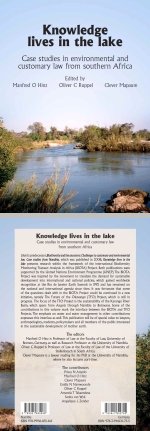
|
 |
New publication: The book "Rehoboth, Namibia - Past & Present" with contributions from several BIOTA-related authors is now available. For the first time there is a comprehensive account of 'Baster matters' set in very broad context: from their beginnings until today. Based on interdisciplinary research the book contains two parts: it focusses on the system of land tenure of Rehoboth, viewing it from political and usage perspectives.
Six authors from three countries worked on the book:
Germany: Hartmut Lang, Christiane Naumann (Social & Cultural Anthropology), Dirk Wesuls (Ecology), Cornelia Limpricht (History)
USA: Sidney Harring (Law)
Namibia: Ibo Zimmermann (Agriculture).
The authors Cornelia Limpricht, Hartmut Lang, Christiane Naumann, Dirk Wesuls and Ibo Zimmermann were involved in the BIOTA-Africa programme - working in the Rehoboth area between 2004 and 2010.
Title of Book: Rehoboth, Namibia - Past & Present (2012)
Edited by: Cornelia Limpricht
Solitaire Press, Windhoek, Namibia
502 pages, ca. 450 figures (photos, maps, graphs)
Namibia: ISBN 978-99945-73-01-1 / Germany: ISBN 978-3-941602-68-7
The book is available in Namibia:
In Rehoboth the book will be distributed by the Rehoboth Community Trust, - in Windhoek and Swakopmund it is available in the usual bookshops like BookDen, BookCellar or Swakopmunder Buchhandlung.
In Germany the book is available at Namibiana Buchdepot Weblink
Download table of contents (26kB) (26kB)
|
 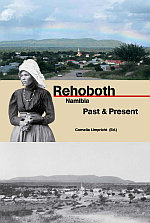
|
 |
Internationaler Workshop zu Para-Ökologen Programmen im Kontext von Forschungsaktivitäten
Über 20 Teilnehmer (Forscher und Para-Ökologen) aus 10 verschiedenen Ländern werden im Rahmen des Workshops ihre Erfahrungen und Konzepte für zukünftige Initiativen diskutieren. Der Workshop wird durch die Volkswagen Stiftung großzügig unterstützt.
14. bis 17. Juni 2011 im Biozentrum Klein Flottbek und Botanischer Garten, Universität Hamburg, Deutschland
Kontakt: uschmiedel@botanik.uni-hamburg.de
|
|
 |
Para-Ökologen im südlichen Afrika Eine Ausstellung über die Arbeit und Erfahrungen der Para-Ökologen im südlichen Afrika im Kontext ihrer Mitarbeit in Biodiversitäts-Forschungsprojekten des Instituts. Para-Ökologen sind Mitglieder von Landnutzergemeinschaften, die beim Biodiversitätsmonitoring und der Forschung im südlichen Afrika mitarbeiten und sich dabei weiterbilden können.
28. Mai bis September 2011, blaue Pyramiden im Botanischen Garten des Biozentrums Klein Flottbek, Universität Hamburg, Deutschland
Kontakt: uschmiedel@botanik.uni-hamburg.de
|
|
 |
Today, the Book series of BIOTA Southern Africa has been launched by The Honourable Minister of Environment and Tourism of Namibia, Netumbo Nandi-Ndaitwah (centre), the Councellor for Development Cooperation of the Embassy of the Federal Republic of Germany in Windhoek, Dr Romeo Bertolini (left), the Master of ceremony, Dr Julian Fennessy, the chair of BIOTA Southern Africa, Norbert Juergens (right) and numerous guests in the frame of a ceremony at the Goethe Centre in Windhoek, Namibia.
more
At the same time, also the Website "Photo Guide to Plants of Southern Africa"
 http://www.southernafricanplants.net, has been launched officially. All plant people are invited to please contribute further photos to expand the number of species, covered by the website. http://www.southernafricanplants.net, has been launched officially. All plant people are invited to please contribute further photos to expand the number of species, covered by the website.
Please contact: photo@southernafricanplants.net
Download Poster of the photoguide
 |
 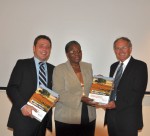
Photo: Steph Fennessy
|
 |
Mit dem dreibändigen Buch Biodiversity in southern Africa präsentiert BIOTA Southern Africa zahlreiche Ergebnisse von fast einem Jahrzehnt Biodiversitätsforschung im südlichen Afrika. Fast 200 Wissenschaftler aus Deutschland, Namibia, Südafrika und einigen anderen Ländern trugen zu diesem Werk mit mehr als 1.400 reich bebilderten Seiten bei. Sie beschreiben ihre Erkenntnisse zu Ökologie und Biodiversität der Biome des südlichen Afrikas, die im Zusammenhang mit dem Einfluss von Landnutzung und Klimawandel zu sehen sind.
In Südafrika wird es eine Buchvorstellung geben im Rahmen von Arid Zone Ecology Forum (AZEF) Konferenz in Gariep Dam (Free State Province, South Africa) in der Zeit vom 4. bis 7. Oktober 2010. Im Oktober und November 2010 wird das kürzlich erschienene Werk in öffentlichen Veranstaltungen in Namibia und Deutschland vorgestellt werden.
mehr |

|
 |
Am 9. August 2010 startete der Global Index of Vegetation-Plot Databases (GIVD) als weltweite Metadatenbank für Vegetationsdatenbanken als wichtiges neues Instrument der Biodiversitätsinformatik. Im 15-köpfigen, internationalen Leitungsgremium sind drei Wissenschaftler der Abteilung Biodiversität der Pflanzen vertreten. Schon kurz nach der Freischaltung der Homepage haben sich über 100 Datenbanken mit rund 2,0 Millionen Vegetationsaufnahmen registriert, darunter auch die drei Datenbanken von BIOTA AFRICA.
mehr |
|
 |
BIOTA East Africa: A new contribution to BIOTA AFRICA’s biodiversity inventory is online: In the vegetation ecology section: Tree and seedlings ecological data for Budongo and Kakamega Forest. This contains data on the tree structure, diversity and diameter growth rates. Further tree seedling dynamics (density, recruitment and mortality) and diversity in the different BDO's of both forests are shown. Additionally values for litterfall for Kakamega are presented.
more |
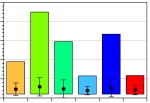
|
 |
BIOTA Southern Africa: The weather data from weather stations at biodiversity observatories in Namibia and South Africa have been updated in April 2010. You can find information on the presently available stations, time periods, values and time resolutions at:
BIOTA Southern Africa Weather Data portal
Please note: There are data from four new weather stations available. Click on one of the links below to go directly to the weather station (observatory).
Kleinberg
Rooisand
Claratal
Sandveld
|
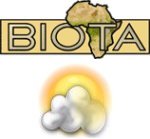
|
 |
On 24-26 February 2010, the 9th international Meeting on Vegetation Databases under the motto "Vegetation Databases and Climate Change" took place in Hamburg, Germany. The Meeting was co-organised by BIOTA AFRICA.
With nearly 150 participants and more than 30 nationalities present, this 9th meeting was by far the largest of this conference series and probably the biggest ecoinformatics conference that has taken place to date. Three keynote lectures, 25 talks, more than 60 posters and five practical workshops were all very well received by the international audience. BIOTA AFRICA was prominently presented by a keynote lecture (Dr. Michael C. Rutherford: Development of the South African National Vegetation Database: applications and links to climate change), three oral contributions from BIOTA Southern Africa (Dr. Ute Schmiedel), BIOTA West Africa (Dr. Marco Schmidt), and BIOTA Maroc (Dr. Manfred Finckh), and one workshop about the BIOTABase software. About one third of the presented posters were devoted to methods and results from BIOTA AFRICA.
Reports, as well as abstracts and PDF's of many contributions are available at Weblink.
Presently, three major publications from the conference are in preparation:
-
Special Feature "Ecoinformatics and global change" in Applied Vegetation Science (registration closed)
-
Special Volume "Vegetation databases for the 21st century" of Biodiversity & Ecology (submission until 30 June 2010)
-
World Index of Plot-Based Vegetation Databases. This will be a comprehensive metadatabase of available digitized relevé data. Already 54 databases with approx. 1.5 million relevés have registered. Deadline for submission: 30 June 2010; registration at Weblink.
Download Book of abstracts (PDF) 
|
 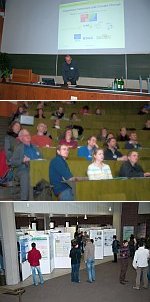
Photos: J.Dengler
|
 |
BIOTA West Africa: K. E. Linsenmair, Zoologie 3, und Robert Foro, Staatssekretär des Forschungsministeriums Burkina Faso, haben am 25.1.2010 das von BIOTA West Africa mit Mitteln des BMBF gebaute Infozentrum zur Biodiversität in Ouagadougou, Burkina Faso, eröffnet.
Ein Infozentrum für Westafrika zum Thema Biodiversität - dieses ambitionierte Vorhaben konnte das interdisziplinäre Forschungsprojekt BIOTA West Africa mit Mitteln des Bundesministeriums für Bildung und Forschung (BMBF) auf dem Campus der Universität Ouagadougou
verwirklichen.
Seit 2001 arbeitet BIOTA West zum Thema Biodiversität in Burkina Faso, Benin und Côte d'Ivoire mit dem Ziel, nachhaltige Nutzungs- und Restaurationsmethoden zu entwickeln, die den langfristigen Schutz und Erhalt von Biodiversität ermöglichen. Um den Transfer der gewonnenen Erkenntnisse in die Bevölkerung und für die verschieden Nutzergruppen (z.B. Bauern, Förster, traditionelle Heiler, Lehrer und Forscher) zu erleichtern, wurde ein Informationszentrum errichtet, in dem alle Information gebündelt vorliegen, die botanischen und zoologischen Referenzsammlungen zugänglich sind und Schulungen für Studenten und Stakeholder veranstaltet werden können. Dies ermöglicht die langfristige Umsetzung der vorgeschlagenen Handlungsempfehlungen und erhöht damit den Erfolg des Projekts: eine nachhaltigere Nutzung und damit der langfristige Schutz von Biodiversität.
Mehr Informationen bei der Koordinationsstelle von BIOTA West Africa.
Externe Presselinks: Sidwaya
Le Pays
Photo: Robert Foro, Staatssekretär im Forschungsministerium von Burkina Faso und K. Eduard Linsenmair, Universität Würzburg, Deutschland, weihen feierlich das Informationszentrum auf dem Campus der Universtität Ouagadougou ein.
|
 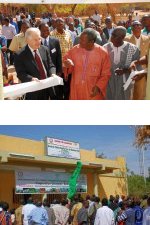
Photos: M. Wegmann
|
 |
BIOTA Southern Africa performs at the Arid Zone Ecology Forum (AZEF) 2009: AZEF took place in the historical Karoo town of Graaff-Reinet, in the Eastern Cape province of South Africa from 5-8 October 2009. The theme of the conference was “Biodiversity conservation in arid zones: people, species and landscapes”.
About 100 people, ranging from scientists, students, planners, land owners, NGO’s and educators working in arid areas, participated in this year’s forum. Plenary addresses included topics such as restoration and local farming perspectives. Delegates also had the opportunity to go on field trips led by local experts and landowners and learn about game farming, arid alien invasions, rehabilitation and riparian ecology. BIOTA Southern Africa was represented by students, para-ecologists and researchers from South Africa, Namibia and Germany and was very successful by being awarded numerous prizes for best presentations by young scientists.
The following BIOTA students have been awarded:
The joint second prize for the best paper presentation has been shared between the two para-ecologists Richard Isaacks and Sebedeus Swartbooi, and Justus Kauartjirue from Polytechnic of Namibia.
The first prize for the best poster speed presentation was awarded to the BIOTA student Clyde Lamberts from ARC / CapeNature. The 2nd prize for best poster speed presentation was awarded to Sarah Meyer from Universities of Karlsruhe and Hamburg.
The conferences closed with the launch of the 20 min documentary “Bridging the gap – para-ecologists in action” produced by the BIOTA para-ecologists in 2009. For more info please see: AZEF
|
 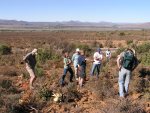
Field trip lead by Jan Vlok
Photo: BIOTA AFRICA
Tessa Oliver
|
 |
BIOTA South Sustaining our Savannas Open Day, Polytechnic of Namibia, on 6 November. A BIOTA south Sustaining our Savannas Open Day was held at the Polytechnic of Namibia, on 6 November, 2009. The aim was to showcase research products (posters and books), films and decision support tools and games to the general public and selected key stakeholders.
After an introduction, participants watched three DVDs (Wiza Wetu, Bridging the Gap and Biodiversity is our Life), had a chance to test and experiment with the Decision Support System (DSS) for Bush Encroachment, the Kalahari Biodiversity Simulator, and the Livestock Production Game. Robert Mukuya, a paraecologist from Rundu, introduced WIza Wetu (a DVD about illegal logging in the Kavango) and Bridging the Gap (a DVD about the paraecologist programme, produced by the paraecologists themselves).
The participants had very good comments regarding the Day, and the products presented. It is hoped that this Open Day will go some way to realizing BIOTA AFRICA's aim of maintaining biodiversity through the various ministries and NGOs in Namibia that are already working hard towards sustainable natural resource management.
Please contact one of the following people for further information:
 Dave Joubert:
djoubert@polytechnic.edu.na
Dave Joubert:
djoubert@polytechnic.edu.na
 Bertchen Kohrs:
bertchenk@iway.na
Bertchen Kohrs:
bertchenk@iway.na
Photo: A planned fire at Neudamm College, October 2009. Research, funded by BIOTA AFRICA, strongly suggests that fires, during the critical time of bush seedling establishment, might be crucial in preventing bush encroachment.
|
 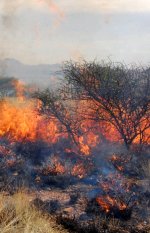
|
 |
A metadata overview has been set up in the renewed data portal. The metadata overview provides information about available data. We invite BIOTA participants to insert metadata about data sets produced by their own workpackages. For that purpose an online form can be used.
BIOTA AFRICA Metadata
|

|
 |
A new data portal about available BIOTA AFRICA data is online. Starting from this portal, the access to various BIOTA AFRICA data like metadata, weather data, vegetation ecology data, animal diversity data and much more is available.
BIOTA AFRICA Data portal
|

|
 |
A fully functional mirror of the main BIOTA AFRICA website has been set up in Namibia.
The two web sites are identical. The mirror site may be accessed by visiting the NBRI (National Botanical Research Institute of Namibia) home page www.nbri.org.na and clicking on the 'BIOTA' link. Setting up of the mirror was conducted under the BIOTA AFRICA BioMonitoring Data Facility, and was motivated by the desire to ease local access to BIOTA data, as well as promote better local ownership of the BIOTA project. Users are encouraged to inform the website developers of their experiences.
|

|
 |
During an expert discussion on "scientific cooperation with developing countries and emerging economies" in Berlin on March 18th 2009, which was organized by the Parliamentary Group of the Christian Democratic Union of Germany (CDU) and the Christian Social Union of Bavaria (CSU), the interdisciplinary and applied research project BIOTA AFRICA was highlighted as one of three best practice cases for this kind of cooperation.
At the beginning of the event, the Federal Minister of Education and Research, Dr. Annette Schavan, highlighted the importance of "science as a key for development". Prof. Dr. Barbara Reinhold-Hurek and Prof. Dr. Michael Kirk, who are conducting research within the BIOTA project since 2000, explained at the meeting how the project puts this into practice. BIOTA AFRICA was envisaged as a best practice case that shows "How German Research and Technology Helps Support Coping with the Consequences of Climate Change".
The BIOTA AFRICA representative from Namibia, Ms Emilia Ndateelela Namwoonde from the University of Namibia (UNAM), contributed to the manifold discussions by giving a very clear insight into the benefits the BIOTA AFRICA initiative has had for African postgraduate students during the past almost 10 years of the project. She appreciated the opportunity of being an "information initiator" for the Namibian science community and for decision makers. Ms Namwoonde also underscored the importance of sharing the findings of research both with the people at the grassroots level, where the research was conducted, as well as with the government level to support policies for sustainable development.
In his closing remarks, Dr. Christian Ruck, Chairman of the Working Group on Economic Cooperation and Development of the CDU/CSU Parliamentary Group, underlined the importance of continuity and sustainability of international research projects.
|
 
Ms Emilia Ndateelela Namwoonde
Foto: BIOTA AFRICA
Hannah Scharlau
|
 |
18 March 2009 - BIOTA in Parliament: The CDU/CSU Parliamentary Group organises a workshop on scientific cooperation with developing countries and emerging economies, involving BIOTA AFRICA.
Weblink 
Weblink 
Invitation and program (PDF) 
(Deadline for registration: 11 March 2009)
|
|
 |
Ein Workshop "BIOTABase Management von Biodiversitätsdaten" wurde am 02./03. Febr. 2009 im Biozentrum der Universität Hamburg durchgeführt. Er wurde von Manfred Finckh (BIOTA Maroc ) und Gerhard Muche (BioMonitoring Data Facility) geleitet. Die deutschen und afrikanischen Teilnehmer arbeiten in den Projekten BIOTA Maroc, BIOTA Southern Africa und in Burkina Faso. Begleitend zum Workshop wurde eine neue BIOTABase Version mit erweiterten und verbesserten Funktionen freigeschaltet.
Download BIOTABase
| 
|
 |
Viele Vorträge und Poster, die beim BIOTA AFRICA - Congress 2008 (29. September - 3. Oktober) präsentiert wurden, sind jetzt als PDF-Download verfügbar.
mehr |
|
 |
"Langsames Sterben am Kap - Klimawandel im südlichen Afrika",
ein Film von Richard Klug, ARD-Studio Johannesburg.
In diesem Film werden – unter Mitwirkung von BIOTA AFRICA – Folgen des Klimawandels auf die Biodiversität thematisiert.
Phoenix:
29. November 2008 11:00 Uhr
30. November 2008 07:30 Uhr
30. November 2008 18:00 Uhr.
In der Sendung "Auslandsreporter" des SWR Fernsehens wurde dieser Film in modifizierter Form am 29. Oktober 2008, 22:30 Uhr, bereits gesendet.
|
|
 |
Successful start of the International Congress on Biodiversity of Africa at Spier, South Africa
Over 350 scientists from more than 15 African countries, Germany and Brazil, high-level representatives also from UNESCO, IUCN, DEAT, DST, GEOBON, OSS, WWF and representatives of the German and several African ministries and local stake holders opened the five days international congress on Biodiversity of Africa at Spier in South Africa. The discussions on the first reflect the urgent need to continue and further strengthen the well-established partnerships between African and German research institutions and scientists. All organisations underscore the necessity of further developing a pan-African network on biodiversity which will support the national initiatives to conserve biodiversity for the sake of sustaining human well-being. It was highlighted that this African network of observation sites should be well-linked to similar initiatives at the global level. The Brazil representative welcomed partnerships with the African network.
The Congress has been organised by the German Federal Ministry of Education and Research (BMBF), the BIOTA AFRICA Project and the South African National Biodiversity Institute (SANBI).
mehr |
 
|
 |
Die Wetterdaten für die Klimastationen bzw. Observatorien in Namibia und Südafrika wurden im September aktualisiert. Klicken Sie auf den Link und wählen dann ein Observatorium über die Drop-Down-Liste oder mit einem Klick auf die Karte aus.
mehr |

|
 |
At the 9th Conference of the Parties to the Convention on Biological Diversity 2008 in Bonn, Germany (CBD COP9), the German Federal Ministry of Education and Research (BMBF) invited farmers, forest guides, park directors, tree nursery workers and scientists from Africa, who cooperate with the BMBF-funded BIOTA AFRICA project, to present their view on biodiversity conservation and sustainable land use in Africa. The brochure “Biodiversity in Africa: The other perspective”, which is now available as download, summarises these fruitful discussions between land users, scientists and decisions makers and underlines the fundamental role that research plays in protecting biodiversity and promoting sustainable land use in Africa.
The brochure gives an outlook on the consolidation and “survival” of initiatives which have been developed or are being supported by the BIOTA AFRICA Project when the project comes to an end in 2010. The brochure will be available as printout at the international BIOTA AFRICA Congress 2008, titled, Biodiversity of Africa - Observation and Sustainable Management for our Future in Spier, South Africa (29 September - 3 October 2008).
Download (2.4 MB) (2.4 MB)
|
 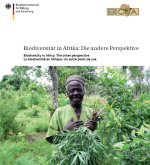
|
 |
GIS training for BIOTA-East counterparts in Nairobi, 6 – 13 August 2008
Having trained BIOTA-East scholars during the 2nd phase of BIOTA in 2005, this time a GIS training was offered to the main counterpart institutions in Nairobi. Kenya Wildlife Service (KWS), Kenya Forest Service (KFS), and Nature Kenya all sent two ‘students’ while National Museums of Kenya (NMK) hosting the venue filled the remaining six seats. Background and GIS knowledge of the participants were rather different and thus the course set-up was a challenge. In the end subproject E02 decided to treat all as beginners, to teach the GIS theory without focusing on particular areas of applications, but to include even complex analysis tasks to be performed by the participants. We aimed to demonstrate that GIS is far more then just the making of maps.
While the mornings were packed with lectures on theory and methods of GIS, in the afternoons people were happy to gain practical experience with GIS. Thanks to ESRI Germany the exercises could be performed with ArcGIS, the software in use at the counterpart institutions, although only on selected computers. Subproject E02 took the chance of testing its BiotaEastGIS Tool, a customised GIS developed based on BIOTA experiences allowing for GIS analysis even by GIS-inexperienced users. A presentation on use of GIS and remote sensing within the BIOTA East Africa project open to anyone interested (the room was packed) showed the potential of such analyses in biodiversity research and management.
For us teaching the course, it was fun and a pleasure to communicate with people we hardly knew before. For the participants we hope that we have stimulated their interest to find out more about the many things for which a GIS can be used. At least they complained that they would have liked a longer training. Thanks to all who contributed to the success of the course! |
 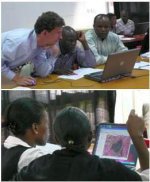
|
 |
In a new paper in the journal Science RJ Scholes and colleagues from DIVERSITAS, NASA and GEO present the plans "Toward a Global Biodiversity Observing System" (Vol 321, 1044-45). Full list of authors: R. J. Scholes, G. M. Mace, W. Turner, G. N. Geller, N. Jürgens, A. Larigauderie, D. Muchoney, B. A. Walther, H. A. Mooney.
mehr |
|
 |
Sign up for BIOTA AFRICA pre- and post-congress excursions.
mehr |

|
 |
BIOTA East Africa, subproject E02, will conduct a GIS course in Nairobi at the National Museums of Kenya (NMK) from August 6th to 13th, 2008. The course will be attended by 12 to 14 participants from four Kenyan counterparts, NMK, Kenya Wildlife Service (KWS), Kenya Forest Service (KFS) and Nature Kenya. Software support is provided by ESRI. |
|
 |
BIOTA AFRICA at COP-9 side event (28 May 2008, 13:15 – 14:45, Saal Bonn, Maritim)
BMBF projects: The other perspective: Visions of African stakeholders on biodiversity conservation and sustainable development Stakeholders (land users and decision makers) from four African countries will present and discuss their experiences on joint research and implementation of sustainable use and conservation practices of biodiversity within the African-German BIOTA AFRICA Project. This research project focuses on the effects of land use and climate change on biodiversity in different African biomes. The land users and the decisions makers from Africa will highlight, how global changes affect their livelihoods and what alternatives the joint BIOTA AFRICA has developed in order to sustainably utilise biodiversity and simultaneously generate income in the future. (6 Stakeholders from Africa plus Facilitator) BIOdiversity Monitoring Transect Analysis in Africa (BIOTA-Africa) is a joint German-African research program which investigates the effects of land use and climate change on biodiversity in Benin, Burkina Faso, Côte d´Ivoire, Kenya, Namibia, South Africa, Uganda. BIOTA AFRICA - scientifically supports sustainable use and conservation of biodiversity in Africa; - has initiated the development and establishment of a continental biodiversity observation network in Africa which will contribute to the aims and implementation of GEOSS (Global Earth Observation System of Systems); - has established a network for observing land degradation and for developing measures to combat and to prevent desertification in Africa; - has developed a network for capacity development and sustainable rural development in Africa.
mehr |
 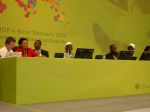
Foto: BIOTA AFRICA/
Tene Kwetche
|
 |
The documentary “Biodiversity is our Life” which BIOTA AFRICA presents on the COP-9 is available on our website.
"Biodiversity is our Life" was edited out of material shot by BIOTA members as part of their research.
mehr |
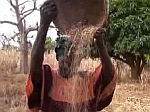
|
 |
Pressemitteilung:
Group on Earth Observation – Biodiversity Observation Network (GEOBON)
Neues Netzwerk zur weltumspannenden Beobachtung von Ökosystemen gegründet.
Berlin/Potsdam, 10. April 2008 – Führende Wissenschaftler aus über 35 Staaten haben die Errichtung eines globalen Netzwerks zur Beobachtung der biologischen Vielfalt beschlossen. Das ist das zentrale Ergebnis einer Tagung, die vom 8. bis 10. April in Potsdam stattgefunden hat. Durch die bessere Vernetzung von Geo-Informationsdaten wollen die Wissenschaftler künftig Aussagen darüber treffen können, wo Ökosysteme am stärksten gefährdet sind und mit welchen Maßnahmen sich diese am besten schützen lassen. An dem heute gegründeten GEO Biodiversity Observation Network (GEO BON) sind insgesamt 70 Nationen und 50 Organisationen beteiligt.
mehr |

|
 |
Floods in Namibia: DLR has posted a new satellite image crisis map related to floods in Namibia (based on TerraSAR-X data) at its website. The map shows the flood situation in the northern Omusati province on March 16, 2008.The water mask was generated from analysis of TerraSAR-X radar satellite imagery. The backdrop is a Landsat ETM satellite image. The map was created at DLR as support to the Charter Call 197.
- DLR Satellite Image Map: Namibia Omusati Province
- Flood Extent March 16, 2008 , 1:100,000
mehr |
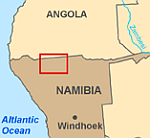
Graphic: DLR
|
 |
Frau Dr. Annette Schavan, Bundesministerin für Bildung und Forschung, wird vom 4. bis 10. Februar 2008 die Republiken Südafrika und Namibia besuchen. Frau Dr. Schavan wird von einer Delegation aus Repräsentanten verschiedener Abteilungen des Bundesministeriums für Bildung und Forschung und Vertretern bedeutender deutscher wissenschaftlicher und wirtschaftlicher Institutionen begleitet.
Während des Besuchs werden bilaterale Forschungsprojekte eine wichtige Rolle spielen. Unter anderem werden sich die Ministerin und die Delegation im South African National Biodiversity Institute (SANBI) über den aktuellen Stand des BIOTA AFRICA Projektes informieren. Das BIOTA Projekt wird durch das South African Department of Science and Technology (DS&T) und das Bundesministerium für Bildung und Forschung (BMBF) finanziert.
In Windhuk wird Dr. Schavan mehrere Minister der namibischen Regierung treffen. Verschiedene namibische Institutionen werden der Delegation der Ministerin ihr Forschungsprofil, ihre Aktivitäten und ihre Projekte vorstellen. Dr Schavan und ihre Begleiter werden auch das BIOTA AFRICA Projekt, auf einer Exkursion zu den BIOTA Biodiversitäts Observatorien Narais und Duruchaus südwestlich von Windhuk besuchen.
mehr |

Foto: BMBF
|
 |
Um die Erfassung und Zusammenführung von Biodiversitätsdaten in Westafrika voranzubringen, trafen sich 25 Biologen aus Benin, Burkina Faso, Deutschland, Elfenbeinküste, Niger und Senegal vom 10.-13. Dezember 2007 im Forschungsinstitut Senckenberg in Frankfurt zu einem gemeinsam von BIOTA und SUN organisierten Workshop.
Die Digitalisierung von primären Biodiversitätsdaten in den Partnerländern wurde unterstützt durch eine zweiwöchige Schulung vom 24. November bis zum 7. Dezember 2007, die taxonomische und geographische Grundlagen, Datenbanklösungen zu Beobachtungs- und Sammlungsdaten, Grundlagen in MS Access, sowie die Einbindung der erfassten Daten in geographische Informationssysteme und räumliche Modellierung beinhaltete.
Während des Workshops wurden Strategien erarbeitet, die digitalisierten Daten zusammenzuführen, zu sichern und gemeinsam zu nutzen. Die vorhandenen Datenbanklösungen wurden kritisch geprüft und Verbesserungsvorschläge von Seiten der Nutzer eingebracht. Eine Folgeveranstaltung zur Auffrischung des erworbenen Wissens und zum Erfahrungsaustausch wird dieses Jahr in Ouagadougou stattfinden. |
 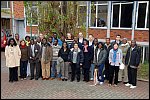
|
 |
Das Wiki Entscheidungshilfesystem (DSS) für Verbuschung auf semiaridem Weideland in Namibia ist auf den Chameleon Webseiten eingeführt.
Dieses Entscheidungshilfesystem (DSS) ist das Ergebnis eines gemeinschaftlichen Forschungsprogramms innerhalb der Polytechnic of Namibia, in dem der Fachbereich Naturschutz und Landwirtschaft (Nature Conservation and Agriculture) die Wissensbasis und die Regeln und der Fachbereich Software Engineering die Software entwickeln. Das DSS ist ein geplantes Werkzeug, um die Betriebsführung von Weideland in semiariden Savannen zu unterstützen.
mehr |
|
 |
Bundeskanzlerin Merkel reiste am 6. Oktober 2007 zum Kap der Guten Hoffnung um sich über Stand und Perspektiven des BIOTA AFRICA Projektes zu informieren.
mehr |
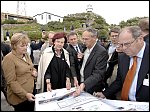
|
|
|




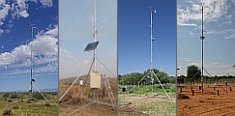

 Go to the WeatherNet
Go to the WeatherNet

